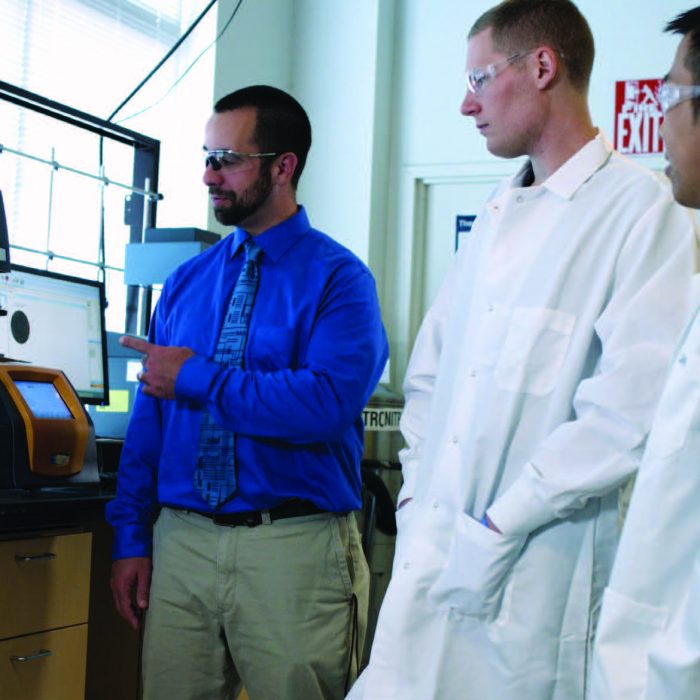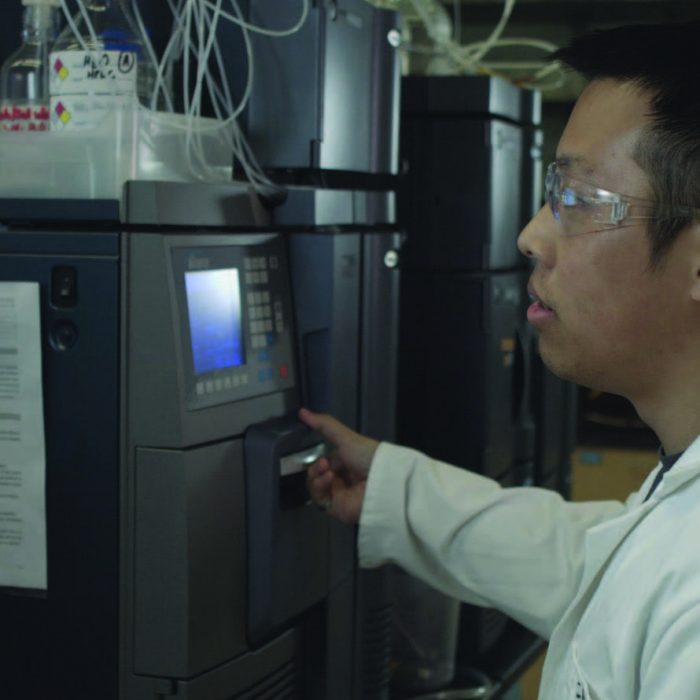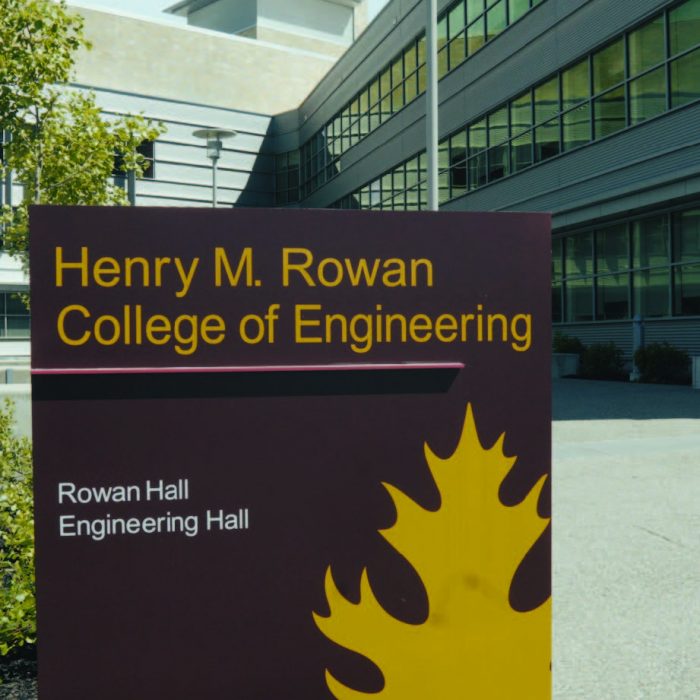Engineering a Greener Approach to Polymers
Rowan University uses Waters and TA Instruments technology to advance materials research with the goal to utilize nature’s chemistry sustainably to enhance material performance
Technology: ACQUITY APC System, TA Instruments Q800 Dynamic Mechanical Analyzer, TA Instruments Discovery Differential Scanning Calorimeter DSC 2500, Waters Alliance HPLC, TA Instruments Discovery Hybrid Rheometer (HR-2), TA Instruments Discovery Analyzer TGA 550
Engineering a Greener Approach to Polymers
Investigations on the use of renewable feedstocks to replace fossil-based raw materials are attracting growing interest in contemporary polymer science from academic, government, and industrial organizations. Bio-based plastics are being developed to limit the use of petrochemical-derived plastics, and the development of sustainable, (bio)degradable, and/or recyclable polymers is a crucial answer to the undesirable environmental, economic, and social costs that are connected to the use of fossil-derived chemicals.
Located in Glassboro, New Jersey, the Henry M. Rowan College of Engineering at Rowan University has launched its Sustainable Materials Research Laboratory (SMRL). The laboratory aims to advance fundamental and applied science and engineering technology related to materials research. SMRL uses advanced materials analysis technology from Waters to accelerate knowledge about potential bio polymers and polymeric composites, as well as to find applications in product design.

South Jersey Technology Park (West Campus) at Rowan University where SMRL resides.
Working With Waters
Waters™ is a leading manufacturer in the materials analysis market with a specific portfolio to support the most demanding applications. Waters provides technology that helps Dr. Stanzione and his team with their chromatography and mass spectrometry activity, and through its TA Instruments portfolio provide innovative thermal analysis and rheometry products. Together with expertise and an extensive support network, Waters provides an ideal partner to understand material characterization. Dr. Stanzione explains how Waters has helped support him throughout his career, most recently in his position at Rowan University: “The relationship with TA Instruments blossomed when I was an undergrad and has now been enhanced with the advanced Waters analytical instrumentation that we need for our work here at RowanUniversity. We used to just get data on properties, but now we can expand on that and link it to structure too.”
Dr. Joseph F. Stanzione, III, associate professor of chemical engineering at Rowan University, leads the SMRL research team that focuses on the utilization of building blocks derived from biomass for the development of polymers, polymer additives, and composites for a wide range of applications — including coatings, adhesives, sealants, high-performance polymers and composites, energy capture and storage, therapeutics, and packaging.
“We have in hand an ever-growing, foundational knowledge base for this work that we see being translatable to the industrial scale thanks to our use of the structure property relationships approach. And, we are doing just that with our government, academic, and industrial partners. Additionally, our goal in the near future is to transition some of our technology into biomedical applications. Our technologies have potential applications in the drug delivery field, as well as in developing better prosthetics.”
– DR. JOSEPH F. STANZIONE, III
Associate Professor of Chemical Engineering at Rowan University.
SMRL’s work could potentially hold great implications for the entire polymer supply chain and any industry that utilizes plastics — which is almost any field imaginable. Dr. Stanzione acknowledges: “It’s a high-risk, high-reward research. However, it is worth pursing and the information we gather will help us move forward and promote meaningful and, hopefully, long-lasting, change towards sustainability.”
Biomass Building Blocks
Historically, triggering factors for rethinking plastics manufacturing and usage originated from the depletion of fossil resources and the rising prices of oil-derived chemicals. Currently, the use of petroleum for plastics, chemicals, and non-fuel use is roughly about 6%. Again, scientists expect that usage to triple by 2050 to about 20%, a dramatic increase in the amount of oil consumption for these types of materials. Additionally, both customers and regulatory agencies are increasingly demanding the development of environmentally friendly and more sustainable materials and processes.
“We can get fatty acids from triglycerides, for example, and those long aliphatic chains can provide flexibility to the polymer network while also providing decent chemical resistance and hydrophobicity. On the flip side, aromatic molecules from certain types of biomass such as lignin and other sources afford high thermal stability, as well as enhance the stiffness. So, if you were to combine these molecules in certain concentrations and formulations, you can tailor the toughness versus the strength of the material, as well as the thermal stability and chemical resistance you need for a particular application. With this knowledge, we can develop new plastics, polymers, and composites with better properties compared to what we currently use.”
– DR. JOSEPH F. STANZIONE, III
Associate Professor of Chemical Engineering at Rowan University.
Through using the technology provided by Waters and TA Instruments, Rowan University can have a full picture of the identification, quantitation, formulations, chemical structures, and physical and performance properties that contribute to their structural-property relationships focused R&D efforts. Dr. Stanzione calls their research approach a “molecularly hybrid approach” that strategically looks at nature’s building blocks to determine if their inherent attributes or characteristics can be combined to make new, better, safer, and more environmentally conscience monomers and polymers. His team is specifically looking for bio resources that can:
- Increase sustainability and circular economy,
- Reduce toxicity,
- Develop novel plastics, polymers and composites, and
- Improve material properties.

Dr. Stanzione in the Sustainable Materials Research Laboratory with SMRL Ph.D.
students Tristan Bacha (middle) and John Chea (right).
Working With Waters
The advanced Waters and TA Instruments technology has served the SMRL team’s needs as they determine the chemical and physical compositions of materials, enabling deeper and more actionable insights from understanding fundamental structure-property relationships. This works to advance the understanding of these bio-based building blocks that show promise for industrial-scale purposes. Dr. Stanzione explains: “The ability to have state-of-the-art, high-resolution and versatile instrumentation to get physical properties and performance attributes of these new materials helps us to fundamentally understand where we went wrong and how we can improve it, or how we got it right and why we got it right.”
The Polymer Supply Chain
SMRL’s research spans the entire polymer supply chain — from material extraction to product development to large-scale commercialization, and then back again for disposal and/or recycling. This 10,000-foot viewpoint of the entire process gives Dr. Stanzione and his team a powerful perspective on the potential for changing the ways we as a society source, use, and dispose of our polymers. Dr. Stanzione describes how this research applies to multiple projects: “One of our major projects has been identifying the building blocks we can get from biomass, the functionality associated with those building blocks, and how we can combine them in strategic ways to make the best structural composites. This is closely related to the world of thermosets, so we’ve been using our molecular hybrid approach to develop such polymers out of these bio-based building blocks with very good success.” And that leads to more ideas about the potential applications for this research.
“Those thermosets could be used for coatings, adhesives, and structural composites. And now we’re looking into whether we can develop them into thermoplastic films and fibers for clothing apparel or other things that use fabrics, like parachutes. We want to step back, see the big picture and say, ‘Okay, we have these data. We have these relationships. How can this be useful for other applications?”
– DR. JOSEPH F. STANZIONE, III
Associate Professor of Chemical Engineering at Rowan University.
SMRL’s ever-expanding research projects require a wide variety of scientific technology and analytical instrumentation, which is where Waters and TA Instruments have played such a pivotal role in their work. Dr. Stanzione explains: “The instrumentation from Waters and TA Instruments helps us get the data to better understand the processing-structure property relationships. For example, the ACQUITY™ advanced polymer chromatography (APC) and high-performance liquid chromatography (HPLC) technology from Waters helps us understand our extractions in the development of thermoplastic polymers. Then, the TA Instruments suite of thermal instrumentation really helps us understand some of the polymerization kinetics, their thermal stabilities, and dynamic mechanical responses to deformation.”
The portfolio of instruments providing solutions for specific challenges helps the SMRL researchers see the bigger picture — and the potential for new product development. Dr. Stanzione describes the importance of these instruments to underpin the research and test and prove his team’s hypotheses: “Sometimes we want to be able to transform these bio-based building blocks into the monomers that we can use in particular polymerization chemistries. So again, the instruments will help us confirm whether or not we’ve done those successfully. Then once we create these polymer systems, the instruments can help us with understanding the polymerization kinetics and, once cured, their performance.”
And it continues as the SMRL team delves deeper in the polymer supply chain. Dr. Stanzione explains: “These instruments can also help us understand the structural-performance relationships. What are their thermal stabilities? What are their mechanical properties? And then what happens to these plastics after use? Do they get recycled or can they be recycled? Or can they decompose or are they biodegradable? So again, these Waters and TA Instruments technologies help us from the very beginning to the very end.”

Ph.D. student, John Chea, working with Waters instrumentation at Rowan University.
Growing Interest In Materials Analysis
Many manufacturers in a wide range of different industries are discovering the value in materials analysis and in the expertise of industry leaders such as Waters and TA Instruments. The portfolio of bespoke technologies coupled with open-minded partnerships — like the one between SMRL and Waters and TA Instruments — can help academia, government, and industry solve similar real-world problems.
Chemical Engineering at Rowan University
SMRL’s goal is to judiciously utilize nature’s chemistries – both those renewed on an annual basis by the biosphere and those nature provided in the form of fossil reserves – to enhance material performance and improve global sustainability. Projects include initiatives funded by the National Science Foundation (generating polymers from bio-oils), National Institutes of Health (studying the toxicity of components in plastics and composites), Army Research Office – Department of the Army (from high performance polymers and composites, to additive manufacturing technology development to evaluating flame-retardant materials that are derived from renewable sources) and more.
“We’re very much interested in continuing to advance the science of sustainable materials by focusing on making polymers and polymer composites out of renewable resources for a wide variety of applications. But at the same time, we’re continuing to develop highly skilled, knowledgeable students who can enter the workforce and use what they learned here at Rowan University throughout their professional careers.”
– DR. JOSEPH F. STANZIONE, III
Associate Professor of Chemical Engineering at Rowan University.
Working With Waters
Since its founding in 1923, Rowan University has evolved to become an internationally recognized University that’s ranked among the best public universities by U.S. News and World Report.1 Today, Rowan’s 18,000+ students choose from more than 74 bachelor’s and 51 master’s degree programs, four doctoral programs and two professional programs. The University is one of just 56 institutions in the country with accredited programs in business, education, engineering and medicine.
Training the Next-Generation of Scientists
SMRL is training the next generation of chemical engineers and scientists by involving Rowan University graduate and undergraduate students and postdoctoral research fellows directly in the research process. Students and fellows research areas include additive manufacturing, chemical processing, energy materials, thermoplastics, and thermosets.
Dr. Stanzione is currently working with several postdocs, eight doctoral students, three master’s students, and more than 20 undergraduate students at SMRL on these leading-edge projects. In the laboratory, his team conducts research and supports projects that meet critical needs of clients and partners, while at the same time developing the hands-on skills they will require in their scientific careers.
That includes a great deal of hands-on experience with both the instrumentation and techniques, as well as soft skills such as communication and presentations to SMRL’s partners and potential collaborators or clients. Waters and TA Instruments research tools were specifically chosen by Dr. Stanzione as they provide the highest level of analysis yet their ease-of-use makes them accessible to students. Access to research grade analytics at an undergraduate level is a very unique concept. The collaboration between Rowan University and Waters/TA Instruments presents a huge opportunity for students in their educational program, preparing them for the next stages in their careers.

The Henry M. Rowan College of Engineering buildings at Rowan University.
“Students learn how to do the science and do it well. They collect data and learn how to interpret that data. They’re seeing it generated in real time, and they learn to decipher any trends. And now they have this toolset in their pockets. So, when they go out into the real world and work on very similar projects, it makes them a lot more marketable and productive because they’ve had exposure to all this different instrumentation, and they bring that experience with them to their future employers.”
– DR. JOSEPH F. STANZIONE, III
Associate Professor of Chemical Engineering at Rowan University.
References
- “National University Rankings.” US News and World Report. Available at: https://www.usnews.com/best-colleges/rankings/ national-universities [2019].

